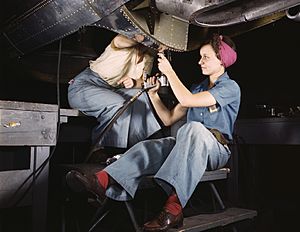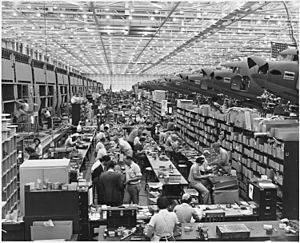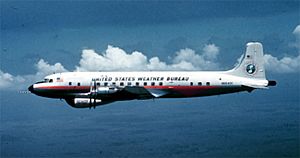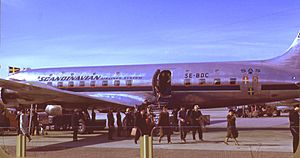Douglas Aircraft Company facts for kids
 |
|
| Industry | Aerospace |
|---|---|
| Fate | Merged with McDonnell Aircraft Corporation |
| Successor | McDonnell Douglas |
| Founded | July 22, 1921 |
| Founder | Donald Douglas |
| Defunct | April 28, 1967 |
| Headquarters | Santa Monica, California, Long Beach, California, U.S. |
|
Key people
|
|
The Douglas Aircraft Company was a famous American company that built airplanes. It was started in 1921 by Donald Wills Douglas Sr. in Southern California. Later, in 1967, it joined with another company called McDonnell Aircraft to form McDonnell Douglas. Douglas Aircraft then became a part of McDonnell Douglas. Even later, in 1997, McDonnell Douglas joined with Boeing, which is another very well-known airplane company.
Contents
History of Douglas Aircraft
Early Days: The 1920s
The Douglas Company was founded by Donald Wills Douglas Sr. on July 22, 1921. It started in Santa Monica, California. One of the company's first big achievements was helping with the first flight around the world in 1924. This amazing journey was done using Douglas airplanes!
In 1923, the U.S. Army Air Service wanted to be the first to fly all the way around the Earth. This project was called "World Flight." Donald Douglas suggested using a changed version of his Douglas DT airplane for this mission. The DT was a two-seater biplane (an airplane with two main wings) that was usually used as a torpedo bomber for the U.S. Navy.
The Douglas DT planes were taken from the factories to be changed for the "World Flight." These special planes were called the Douglas World Cruiser (DWC). Jack Northrop, who later started his own airplane company, designed the fuel system for these planes. After a test flight in November 1923 went well, the Army asked Douglas to build four more of these planes.
Because the journey would be very long and difficult, many spare parts were prepared. This included 15 extra engines and 14 extra sets of floats (for landing on water). Enough parts to build two more airplanes were also sent to airports along the flight path. The last of these special airplanes was given to the U.S. Army in March 1924.
The four airplanes started their journey from Seattle, Washington, on April 6, 1924, flying west. Two of them successfully returned to Seattle on September 28, 1924, to a huge celebration! One plane was lost in fog, and another had to land in the Atlantic Ocean and sank. After this successful flight, the Army Air Service ordered six more similar planes. The success of the DWC made Douglas Aircraft Company famous around the world. It even led them to use the motto: "First Around the World – First the World Around."
Douglas Aircraft first used a logo with two "D" letters and wings. After the success of the World Cruiser flight, they changed their logo. The new logo showed three airplanes flying around a globe. Over time, this logo changed to show an airplane, a missile, and a globe. This logo was later used by McDonnell Douglas and then became the basis for Boeing's current logo after they merged.
Before World War II
Douglas Aircraft designed and built many different types of planes for the U.S. military. This included planes for the Navy, Army Air Forces, Marine Corps, Air Force, and Coast Guard.
The company first built torpedo bombers for the U.S. Navy. But they soon made many different versions of these planes, including reconnaissance planes (for spying) and airmail planes (for carrying mail). Within five years, Douglas was building about 100 airplanes every year. Some of the early employees at Douglas became famous later, like Ed Heinemann and Jack Northrop.
Douglas kept building planes for the military and also started making amphibian airplanes (planes that can land on both land and water) in the late 1920s. They also moved their factories to Clover Field in Santa Monica, California. The Santa Monica factory was so big that people who delivered mail inside the company used roller skates to get around! By the end of World War II, Douglas had factories in many cities, including Santa Monica, El Segundo, Long Beach, Torrance, California, Tulsa, Midwest City, Oklahoma, and Chicago, Illinois. In November 1928, the company officially became the Douglas Aircraft Company.
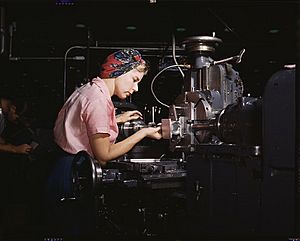
In 1934, Douglas made a commercial (for regular people) twin-engined transport plane called the Douglas DC-2. This was followed by the very famous Douglas DC-3 in 1936. Douglas made many kinds of aircraft, including airliners (passenger planes), bombers, fighter aircraft, and planes for carrying goods.
The company is most famous for its "DC" (Douglas Commercial) series of planes. The Douglas DC-3 is often called one of the most important transport planes ever made. It was also built as a military transport plane called the C-47 Skytrain (or "Dakota" in Britain). Many Douglas planes were used for a very long time.
World War II and Beyond
During World War II, Douglas worked with other companies like Boeing to build the B-17 Flying Fortress bomber. After the war, Douglas also built another Boeing plane, the B-47 Stratojet jet bomber, under a special agreement.
World War II was a huge time for Douglas. The company was one of the top five U.S. companies in terms of how much it produced for the war. Douglas made almost 30,000 aircraft between 1942 and 1945! Their workforce grew to 160,000 people. They built many important planes, including the C-47 Skytrain, the DB-7 (also known as the A-20 Havoc), the SBD Dauntless dive bomber, and the A-26 Invader.
After the War
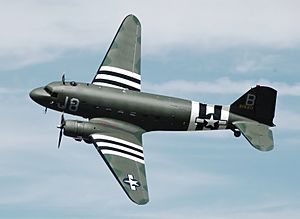
After World War II ended, Douglas Aircraft faced big changes. The government stopped ordering so many planes, and there were many extra aircraft available. Douglas had to let go of almost 100,000 workers.
The U.S. Army Air Forces started a project called 'Project RAND' to plan for future weapons. In March 1946, Douglas Aircraft Company got the job to research long-range warfare. This project later became the famous RAND Corporation.
Douglas kept making new planes. They built the successful four-engine Douglas DC-6 in 1946. Their last commercial plane that used propellers (not jets) was the Douglas DC-7 in 1953. Douglas also started making jet planes. Their first jet for the U.S. Navy was the F3D Skyknight in 1948, followed by the more modern-looking F4D Skyray in 1951. Douglas also made commercial jets, like the Douglas DC-8 in 1958, which competed with Boeing's new 707 jet.
Douglas was also a leader in other areas. They worked on ejection seats (seats that can shoot a pilot out of a plane in an emergency), different types of air-to-air missiles (missiles that fly from one plane to another), and surface-to-air missiles (missiles that fly from the ground to a plane). They also made rockets, bombs, and bomb racks.
In the 1950s, the company was ready to get into the new missile business. Douglas started making entire missile systems. They became the main company for the Nike missile program in 1956, and also for the Skybolt missile and the Thor ballistic missile programs. Douglas also won contracts from NASA, the U.S. space agency. They helped design parts for the Saturn IB and Saturn V rockets, which were used for space missions.
Company Mergers
In 1967, Douglas Aircraft was having trouble building enough DC-8 and DC-9 airliners and the A-4 Skyhawk military planes. They also had problems with quality and money. At the same time, the Vietnam War caused shortages of materials. Because of these difficulties, Douglas was open to an offer from McDonnell Aircraft Corporation. On April 28, 1967, after almost four years of talks, the two companies joined together to become McDonnell Douglas Corporation.
The two companies were a good match. McDonnell was a big company that built planes for the military, but it had almost no business building planes for regular people. Douglas's commercial contracts would help McDonnell if military orders slowed down. On the other hand, McDonnell had enough money to help Douglas with its financial problems. Soon after the merger was announced, McDonnell bought a lot of Douglas stock to help Douglas with its immediate money needs.
The new combined company was based at McDonnell's location in St. Louis, Missouri. They used a changed version of Douglas's logo. Donald Wills Douglas Sr. became an honorary chairman (a special advisor) of the new company until he passed away in 1981. Douglas Aircraft Company continued to exist as a part of McDonnell Douglas, with Donald Douglas's son, Donald Wills Douglas Jr., as its president. Later, David S. Lewis became the head of Douglas Aircraft. He helped the division become successful again, and then he became the president of McDonnell Douglas in 1969. Meanwhile, Douglas's space and missile division became a new part of the company called McDonnell Douglas Astronautics Company.
McDonnell Douglas later merged with its main competitor, Boeing, in 1997. Boeing combined Douglas Aircraft into its Boeing Commercial Airplanes division. The Douglas Aircraft name was then retired after 76 years. The last commercial airplane built in the Long Beach factory, the Boeing 717 (which was a newer version of the Douglas DC-9), stopped being made in May 2006. By 2011, the Boeing C-17 Globemaster III was the last plane being put together at the Long Beach factory. The very last C-17 was finished in late 2015. However, the old Douglas logo is still kept at the factory, even though Boeing doesn't use it anymore.
Products
Aircraft
- Douglas 1211-J
- Douglas 2229
- Douglas A-1 Skyraider (1945)
- Douglas XA-2 (c. 1926)
- Douglas A-3 Skywarrior (1952)
- Douglas A-4 Skyhawk (1954)
- Douglas A-20 Havoc (1938)
- Douglas A-26 Invader (1942)
- Douglas A-33 (1941)
- Douglas A2D Skyshark (1950)
- Douglas Y1B-7, B-7, O-35 (1931)
- Douglas B-18 Bolo (1935)
- Douglas XB-19 (1941)
- Douglas XB-22 (1930s)
- Douglas B-23 Dragon (1939)
- Douglas XB-31
- Douglas XB-42 Mixmaster, XA-42 Mixmaster (1944)
- Douglas XB-43 Jetmaster (1946)
- Douglas B-66 Destroyer (1954)
- Douglas BTD Destroyer
- Douglas C-1 (1925)
- Douglas C-47 Skytrain
- Douglas AC-47 Spooky
- Douglas XCG-17
- Douglas C-54 Skymaster (1942)
- Douglas C-74 Globemaster (1945)
- Douglas C-124 Globemaster II (1949)
- Douglas C-132 (1957, canceled)
- Douglas C-133 Cargomaster (1956)
- Douglas Cloudster (1921)
- Douglas Cloudster II (1947)
- Douglas D-558-1 Skystreak (1947)
- Douglas D-558-2 Skyrocket (1948)
- Douglas D-906
- Douglas DA-1 Ambassador (1928)
- Douglas DC-1 (1933)
- Douglas DC-2 (1934)
- Douglas DC-3 (1935)
- List of Douglas DC-3 family variants
- Douglas DC-4E (1938)
- Douglas DC-4 (1939; new design unrelated to DC-4E)
- List of Douglas DC-4 variants
- Douglas DC-5 (1939)
- Douglas DC-6 (1946)
- Douglas DC-7 (1953)
- Douglas DC-8 (piston airliner)
- Douglas DC-8 (1958)
- Douglas DC-9 (1965)
- Douglas DC-10 (1970)
- Douglas DF (1930s)
- Douglas DT (1921)
- Douglas Dolphin (1930)
- Douglas XFD (1933)
- Douglas F3D Skyknight (1948)
- Douglas F4D Skyray (1951)
- Douglas F5D Skylancer (1956)
- Douglas F6D Missileer (1959, canceled)
- Douglas M-1 (1925)
- Douglas O-2 (1924)
- Douglas O-31 (1930)
- Douglas O-38 (1931)
- Douglas O-43 (1934)
- Douglas O-46 (1936)
- Douglas O2D (1934)
- Douglas YOA-5 (1935)
- Douglas XP-48
- Douglas XP3D (1935)
- Douglas SBD Dauntless (1938)
- Douglas XT-30
- Douglas T2D (1927)
- Douglas XT3D (1931)
- Douglas TBD Devastator (1935)
- Douglas XTB2D Skypirate (1945)
- Douglas World Cruiser (DWC) (1923)
- Douglas X-3 Stiletto (1952)
Missiles and Spacecraft
- Roc I
- AAM-N-2 Sparrow I (1948)
- MIM-4 Nike Ajax (1959)
- MGM-5 Corporal
- WAC Corporal
- MIM-14 Nike Hercules
- Thor (rocket family)
- PGM-17 Thor
- Thor-Able
- Thor-Ablestar
- Thor-Agena
- Thorad-Agena
- Thor DSV-2
- Thor DSV-2U
- Thor-Burner
- Thor-Delta
- LIM-49 Spartan
- LIM-49 Nike Zeus
- GAM-87 Skybolt
- MGR-1 Honest John
- AIR-2 Genie (1956)
- MGR-3 Little John
- Delta
- Douglas SASSTO
- Saturn S-IV stage
- Saturn S-IVB stage
- Manned Orbiting Laboratory space station
See also
 In Spanish: Douglas Aircraft Company para niños
In Spanish: Douglas Aircraft Company para niños


